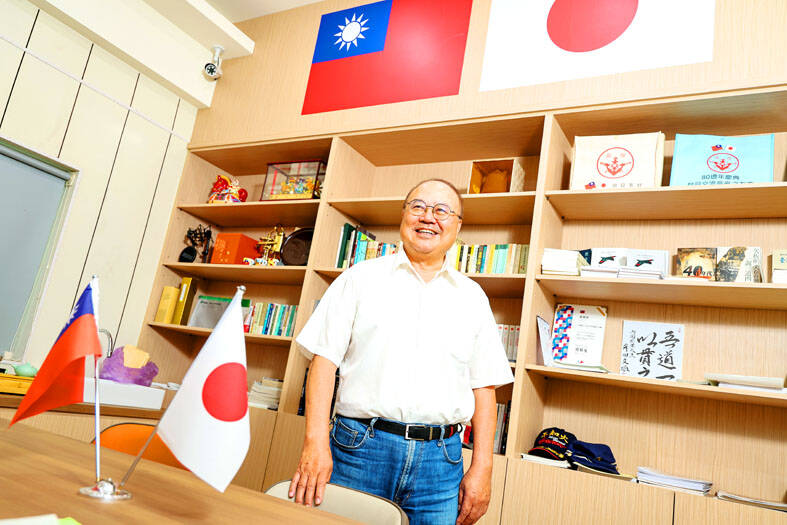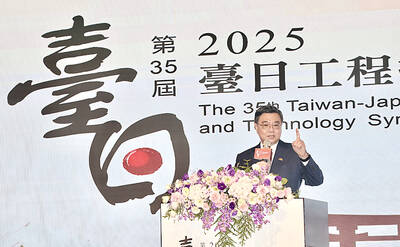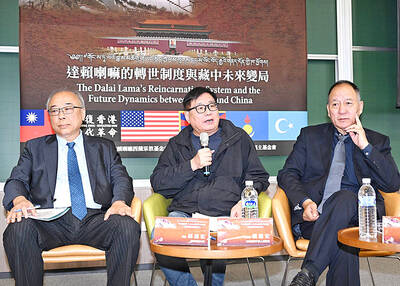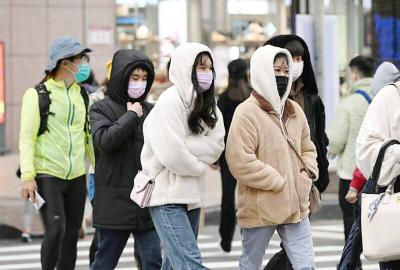When Emperor Hirohito announced Japan’s unconditional surrender on Aug. 15, 1945, marking the end of World War II, some Taiwanese had ambivalent feelings, including those serving at a Navy arsenal in Kouza, Kanagawa Prefecture, Japan.
In 1942 the imperial Japanese military failed to gain the upper hand in the Pacific naval battles. It lost four aircraft carriers along with many warplanes in the decisive Battle of Midway. To rapidly boost fighter production, Japan built the Kouza Arsenal to manufacture Raiden (Thunderbolt) interceptors, intended to defend the Japanese mainland and Imperial Palace.
Those working at the warplane factory included a group of young Taiwanese, aged between 13 and 18, nicknamed the “Sparrow Corps.”

Photo: CNA
By the end of the war, the young workers had built a total of 128 Raiden fighter aircraft, accounting for one-fifth of Japan’s total production. These planes enabled the Imperial Japanese Navy’s 302nd Air Group at Atsugi Air Base to rapidly take off and land over Tokyo Bay to intercept enemy aircraft.
Former lawmaker Ho Min-hao (何敏豪), who chairs the Taiwan-Japan Kouzakai Friendship Association, cited his uncle, Ho Chun-shu (何春樹), as recalling that when the emperor announced Japan’s defeat, many of the Taiwanese youth workers’ legs gave way as they fell to their knees in tears.
Others felt “at last, everything was over” and they could return home to Taiwan, Ho Min-hao said, and “I think my uncle was also in low spirits with both feelings coexisting in his heart.”
Another youth worker, Chen Chen-chien (陳臣堅) once recalled in an interview at Academia Historica: “My feelings were quite complicated. On the one hand, I was very happy that I could finally return to Taiwan; on the other, I was surprised -- how could we have lost the war? Weren’t we working so hard every day?”
Ho Chun-shu and Chen answered a talent recruitment campaign launched by the then Taiwan Governor-General’s Office to work at Kouza Naval Arsenal or other warplane manufacturing factories across Japan during the war.
According to historical documents stored in Taiwan’s national data banks, the office attracted young Taiwanese to enlist by offering preferential work-study arrangements and the opportunity to obtain an academic qualification equivalent to that of an industrial or secondary school upon completion of training.
The original plan was to recruit 30,000 people, but after physical examinations, written tests, and oral interviews, only 8,419 qualified. Most of those admitted ranked in the top three academically at their schools in Taiwan, making them the elite of their generation.
During their apprenticeship in Japan, the young workers practiced manufacturing skills such as hammering iron and cutting steel plates before being sent in batches to Kouza or other aircraft factories to support production.
Born in 1929, Ho Chun-shu could not continue his education due to poverty, his nephew said during a recent media interview.
After learning of the recruitment drive, his uncle decided to join the youth worker program, Ho Min-hao said, adding the promise of a salary along with school enrollment benefits persuaded him to go to Japan, and after returning he used his wages and severance pay to pay off his family’s debts.
Ho Min-hao explained that back then, his grandfather worked building railways at an Imperial Japan Sugar Corp. plant, earning 30 Japanese yen a month -- enough to support the entire family.
The starting monthly wage for a youth worker was 25 yen, and those sent to assist private companies could earn additional allowances. As a result, most youth workers earned over 30 yen a month, the young Ho said.
The Imperial Japanese Navy also promised that after the war, youth workers would be treated as technical high school graduates, qualifying them to apply directly to universities -- a strong incentive at the time.
Ho Chun-shu’s considerations mirrored those of most Kouza youth workers of the era, though the reality of that choice was far from easy.
The average age of more than 8,000 youth workers sent to Japan was just 14.5 years old. They left their families to go to a foreign country (though Taiwan was governed by Japan at the time) where the climate was far colder than in subtropical Taiwan.
According to Ho Min-hao, aside from the homesickness and seasickness during the voyage, what Ho Chun-shu found hardest to endure was the biting cold. In Kouza, he often faced bitter down-slope winds and snowstorms, and frostbite and chilblains were common among youth workers.
Harsh weather, combined with the war reaching the Japanese mainland, claimed the lives of more than 50 Taiwanese youth workers, either through illness or in combat-related incidents.
On July 30, 1945, less than a month before the war ended, Ho Chun-shu personally witnessed the tragic deaths of six youth workers who were killed by American bombs while returning to the factory.
After the end of the war, some of the youth returned to Taiwan where they kept in touch, mostly in private due to their service in Japan. It was not until martial law was lifted in 1987 that they formally established the Taiwan Kouza Association, also called Kouzakai, to promote exchanges between the two sides.
“Time spares no one. The youth workers are now, on average, over 95 years old, and their numbers have dwindled from more than 2,000 at the first gathering to perhaps only four or five this year,” said Ho Min-hao, who has taken on the responsibility of passing on the youth workers’ stories and fostering Taiwan-Japan relations.
He said he believes Taiwan’s collective memory should not be erased because of differing political views, and that the emotional bond between Taiwan and Japan is unique.
Whether it is the Taiwanese youth workers, the Taiwan- Japan Maritime Exchange Association, or the “Wansei” Japanese born in Taiwan, all have been key factors in sustaining Taiwan-Japan ties over the past 80 years, he said.

ALIGNED THINKING: Taiwan and Japan have a mutual interest in trade, culture and engineering, and can work together for stability, Cho Jung-tai said Taiwan and Japan are two like-minded countries willing to work together to form a “safety barrier” in the Indo-Pacific region, Premier Cho Jung-tai (卓榮泰) yesterday said at the opening ceremony of the 35th Taiwan-Japan Modern Engineering and Technology Symposium in Taipei. Taiwan and Japan are close geographically and closer emotionally, he added. Citing the overflowing of a barrier lake in the Mataian River (馬太鞍溪) in September, Cho said the submersible water level sensors given by Japan during the disaster helped Taiwan monitor the lake’s water levels more accurately. Japan also provided a lot of vaccines early in the outbreak of the COVID-19 pandemic,

Kaohsiung Mayor Chen Chi-mai (陳其邁) on Monday announced light shows and themed traffic lights to welcome fans of South Korean pop group Twice to the port city. The group is to play Kaohsiung on Saturday as part of its “This Is For” world tour. It would be the group’s first performance in Taiwan since its debut 10 years ago. The all-female group consists of five South Koreans, three Japanese and Tainan’s Chou Tzu-yu (周子瑜), the first Taiwan-born and raised member of a South Korean girl group. To promote the group’s arrival, the city has been holding a series of events, including a pop-up

TEMPORAL/SPIRITUAL: Beijing’s claim that the next Buddhist leader must come from China is a heavy-handed political maneuver that will fall flat-faced, experts said China’s requirement that the Dalai Lama’s reincarnation to be born in China and approved by Beijing has drawn criticism, with experts at a forum in Taipei yesterday saying that if Beijing were to put forth its own Dalai Lama, the person would not be recognized by the Tibetan Buddhist community. The experts made a remarks at the two-day forum hosted by the Tibet Religious Foundation of His Holiness the Dalai Lama titled: “The Snow Land Forum: Finding Common Ground on Tibet.” China says it has the right to determine the Dalai Lama’s reincarnation, as it claims sovereignty over Tibet since ancient times,

Temperatures in some parts of Taiwan are expected to fall sharply to lows of 15°C later this week as seasonal northeasterly winds strengthen, the Central Weather Administration (CWA) said today. It is to be the strongest cold wave to affect northern Taiwan this autumn, while Chiayi County in the southwest and some parts of central Taiwan are likely to also see lower temperatures due to radiational cooling, which occurs under conditions of clear skies, light winds and dry weather, the CWA said. Across Taiwan, temperatures are to fall gradually this week, dropping to 15°C to 16°C in the early hours of Wednesday